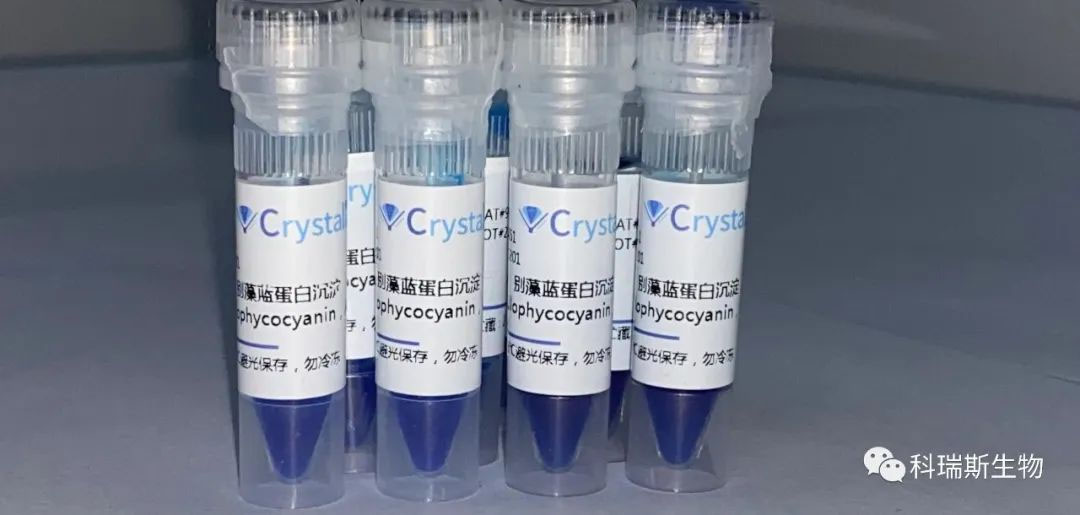|
1. Introduction to phycocyanin
Allophycocyanin (APC) is a phycobiliprotein isolated from spirulina. Like other phycobiliproteins, allophycocyanin is a fluorescent substance with extremely high absorption and quantum efficiency. It is a protein that can be easily linked to antibodies and other proteins through conventional protein cross-linking techniques without altering its spectral characteristics. Phycocyanin is unstable in the main phycobiliproteins and is prone to dissociation at low concentrations (including certain experimental concentrations). Cyanoglycan conjugates are commonly used in flow cytometry, gene chip, and ELISA experiments, but are rarely used for fluorescence microscopy detection due to their rapid quenching by light.
2. Test Materials
Do not use phycocyanin dye; PD-10 column (Sephadex G-25M, Sephadex, Sephadex, Sephadex, Sephadex, Sephadex, Sephadex, Sephadex G-25M, Sephadex, Sephadex G-25M, Sephadex, Sephadex G-25M, Sephadex G-25M, Sephadex G-25M, Sephadex G-25M, Sephadex G-; NAP5 column (Sephadex G-25 DNA grade, Sephadex gel chromatography column), product of Cytova Company, Catalog No. 17-0853-02; Succinimide 4- (N-methylmaleimide) cyclohexane-1-carbonate (SMCC), Thermo, catalog number 22360; N-Ethylmaleimide (NEM), Thermo Corporation, catalog number 23030; Dimethyl sulfoxide (DMSO), Thermo Corporation, catalog number No. D12345.
III. Experimental Methods
1、 Derivatives of phycocyanin
① Dissolve succinimide-4- (N-methylmaleimide) cyclohexane-1-carbonate (SMCC) in anhydrous dimethyl sulfoxide (DMSO) to prepare a 10 mg/mL mother liquor. The crosslinking molar ratio of APC to succinimide-4- (N-methylmaleimide) cyclohexane-1-carbonate (SMCC) is 1:20. After sealing with aluminum foil, rotate and react at room temperature for 60 minutes to derivatize the amino groups on APC molecules with succinamide.
② Exchange buffer was used to pre balance the gel chromatography column, the derived APC was passed through the column, and the protein peak was collected.
2、 Antibody processing
① Dissolve dithiothreitol (DTT) in distilled water to prepare a 1 mol/L dithiothreitol (DTT) mother liquor. Adjust the concentration of the antibody to at least 4 mg/mL.
② Add 20 microliters of dithiothreitol (DTT) mother liquor to each milliliter of antibody solution, let it stand at room temperature for 30 minutes, and open the disulfide bond of the antibody to form a thiol group.
③ Exchange buffer solution to pre balance the gel column, pass the reaction solution through the column, and collect the antibody part.
3、 Covalent cross-linking between phycocyanin and antibodies
① Add 1.5 milligrams of succinimide-4- (N-methylmaleimide) cyclohexane-1-carbonate (SMCC) derived APC per milligrams of antibody, seal with aluminum foil, and rotate at room temperature for 60 minutes to achieve covalent crosslinking between the maleimide group and the thiol group on the antibody. (Note: Gradient testing is required for concentration, and the recommended dye concentration is 4mg/mL.)
② Dissolve 10 milligrams of N-ethylmaleimide (NEM) in 1.0 milliliter of anhydrous dimethyl sulfoxide (DMSO) to prepare N-ethylmaleimide (NEM) mother liquor (currently prepared and used).
③ Add 3.4 microliters of N-ethylmaleimide (NEM) mother liquor to each milligram of antibody, seal with aluminum foil, and rotate at room temperature for 60 minutes. After the reaction, block the thiol groups on the antibody.
4、 Storage of cross-linked substances
Dialysis of the crosslinked material in storage buffer and storage at 2-8 ℃.
4. Cross linked phycocyanin
Due to the hydrolysis of naturally extracted allophycocyanin in diluted solutions (low concentrations) or exposure to solubilizing salt environments, it is usually crosslinked to maintain stability in biological reaction systems. Using chemical methods to treat natural phycocyanin in alpha; Andβ Chemical cross-linking occurs between subunits, resulting in cross-linked phycocyanin, also known as CL-APC. CL-APC is much more stable than APC, not only enhancing the stability of the product, but also retaining the fluorescence and spectral integrity of natural dyes. The antibody labeling scheme for cross-linked allophycocyanin is consistent with that of allophycocyanin, resulting in higher fluorescence intensity after labeling.
Korys Biotech can provide alternative phycocyanin (APC) and more stable cross-linked alternative phycocyanin (Cl APC) for customers to choose from. Derived phycocyanin can also be provided to reduce experimental steps.

|